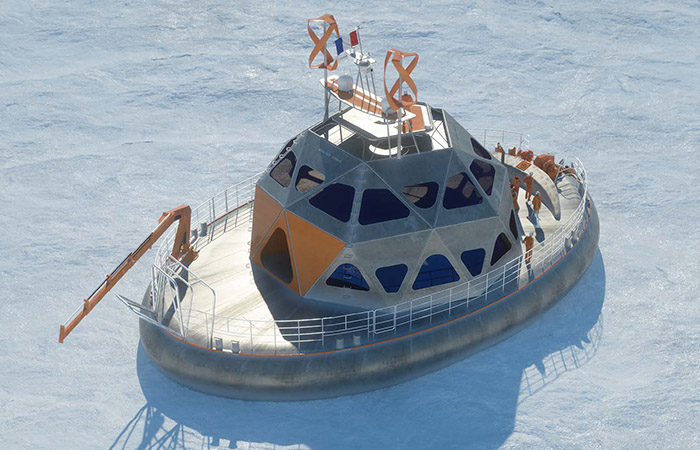CHARTING THE ARCTIC
By Moira Baird, BA'86

DR. MAXIME GEOFFROY, a research scientist at the Marine Institute, is participating in the Arctic research project of a lifetime.
He is part of an international committee planning a 20-year study of the central Arctic Ocean and the impact of climate change in the region. It’s scheduled to begin in 2025 using a purpose-built, floating platform called the Tara Polar Station. The station will drift across the ocean with the sea ice while researchers make observations, gather data and conduct experiments.
“Having a platform where researchers will be taking measurements year after year for two decades will provide unique datasets that will help us understand the seasonality of the central Arctic Ocean’s marine ecology and the long-term changes happening there,” said Dr. Geoffroy.
“The committee will determine the types of research projects to be done, how to gather the data and what kind of measurements will be taken.”
Construction of the Tara Polar Station began last year and was funded by France and the European Union. It is designed to withstand ice pressures and accommodate up to 20 people in summer and 12 during the polar winter, along with two dogs serving as polar bear guards and therapy pets.
Changing ecosystem
The station is expected to drift in ice across the central Arctic Ocean for up to 18 months at a time during 10 consecutive expeditions. However, Dr. Geoffroy says the duration of the trips may decrease over time due to climate change.
“In 2045 it’s probably going to take less time,” he said. “It could be as little as one year because the ice is shrinking so quickly in the summer. We know this is one the fastest changing ecosystems in the world — it warms up to four times faster than the rest of the planet.”
The central Arctic Ocean spans 2.8-million-square kilometres.
Arctic expertise

Dr. Geoffroy has conducted research in the Arctic since 2008. He specializes in Arctic and subarctic fish ecology and the use of acoustics and new technology to study marine ecosystems. Fisheries acoustics use sound waves to estimate the number of fish, as well as their distribution, shape and size.
He works with the Marine Institute’s Centre for Fisheries Ecosystems Research, where he supervises 12 graduate students and post-doctoral fellows.
Dr. Geoffroy was invited to participate in the Tara Polar Station through collaborations with researchers from Laval University in Quebec and the University of Tromsø in Norway, who are also participating in the project. The multidisciplinary science committee includes members from nine countries.
Twilight zone
Increasingly, Dr. Geoffroy’s research focuses on mesopelagic fish, which play an important role in the ocean’s carbon cycle.
These small fish live in what we call the twilight zone, where you have less than one per cent of the light that you would have at the surface of the ocean. The twilight zone is usually between 200 metres and 1,000 metres deep. A lot of mesopelagic fish within that twilight zone form very abundant stocks of fish.– Dr. Maxime Geoffroy
The fish migrate at night to the ocean surface to feed on zooplankton and return to the depths during daylight. As they return to deeper water, their respiration and waste transports carbon from the surface to the deeper ocean — also known as carbon export.
“They help regulate the climate, and we know it’s a big part of the carbon cycle in the ocean,” Dr. Geoffroy continued. “We don’t know how exactly it’s happening in the Arctic, where you have a seasonal light cycle rather than a daily light cycle as in other oceans. It’s one of the questions we’ll be able to tackle with the Tara Polar Station.”
Southern fish migration
Another question focuses on the movement of southern fish into Arctic waters. Dr. Geoffroy says fish — such as cod, redfish and mackerel — have been found in the North, leading to predictions that North Atlantic fish will migrate further north due to climate change.
“It’s not clear if they’re able to survive a dark, cold winter in the Arctic. So that’s a question we’re trying to answer: the rate of change in the fish community year-round.”
DNA analysis
The station’s laboratories will be equipped with DNA sequencing tools that enable researchers to analyze environmental DNA in seawater samples to identify marine species.
“The Tara Ocean group of scientists have used this genetic analysis in the past. It’s been done mainly for micro-organisms and phytoplankton, and now we’re expanding this technique to fish and larger animals,” said Dr. Geoffroy.
Construction of the polar station is led by Tara Ocean Foundation, a French non-profit organization dedicated to ocean science, exploration and education.

